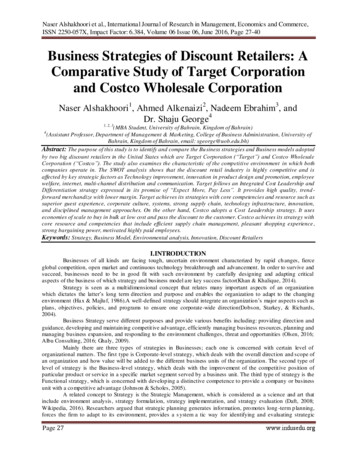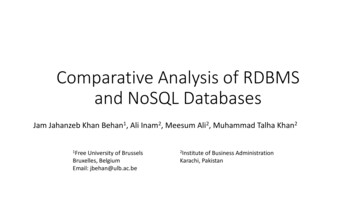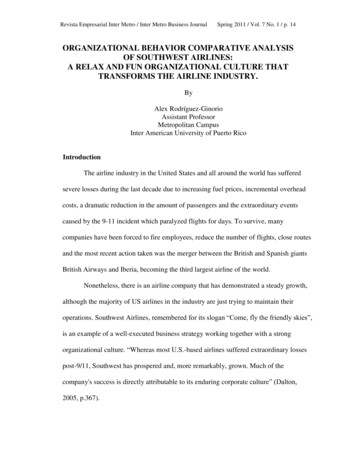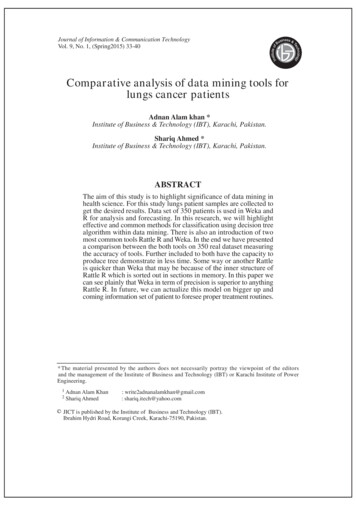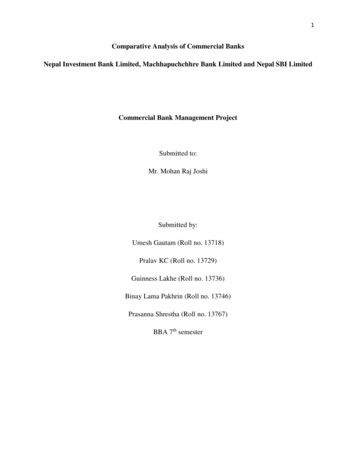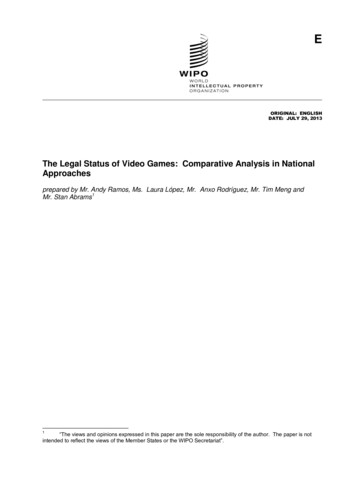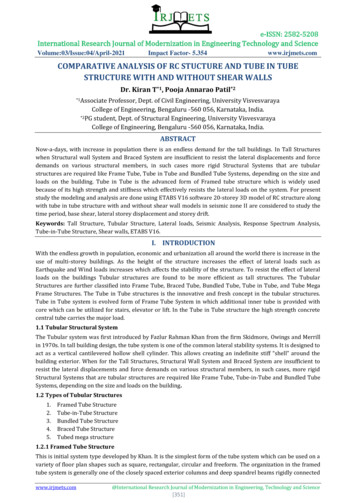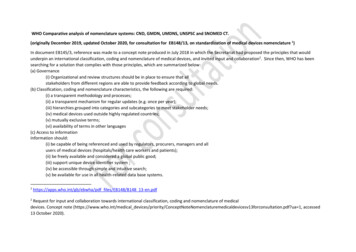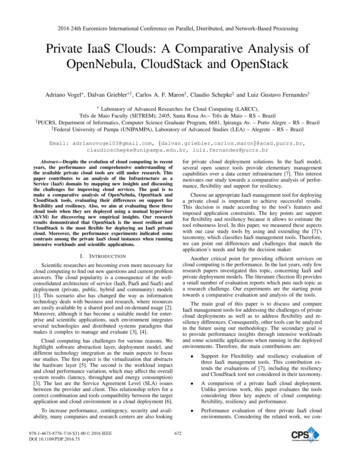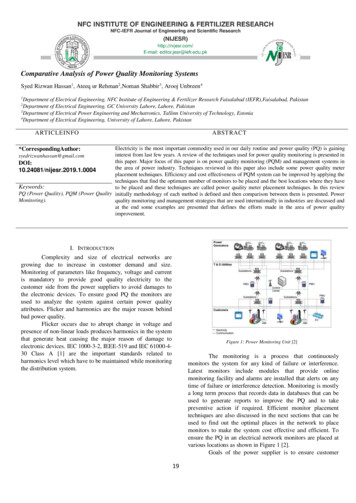
Transcription
Hussain A. Ali Mahdi et al International Journal of Business Management and Economic Research(IJBMER), Vol 6(3),2015,167-177A Comparative Analysis of Strategies and BusinessModels of Nike, Inc. and Adidas Group with specialreference to Competitive Advantage in the context of aDynamic and Competitive EnvironmentHussain A. Ali Mahdi1, Mohammed Abbas2,Taher Ilyas Mazar31,2,3MBA Student,University of Bahrain, Kingdom of BahrainDr. Shaju George44Assistant Professor,Department of Management & MarketingCollege of Business AdministrationUniversity of BahrainKingdom of BahrainAbstract:Strategy is about the most crucial and key issues for the future of organizations. Strategy is also important toexplore several strategic options, investigating each one carefully before making strategic choices. The studyincorporates a rigorous and systematic effort to uncover the strategies and its impact on the company’sperformance by analysing case studies, articles and the annual report of Nike Inc. and Adidas Inc. The studyattempts to find out the relevance of the strategies adopted by these companies, which are globally successfulathletic apparel companies in the context of Bahrain. The findings of the study highlight Nike’s strategies whichfocus on innovation and emphasis on its research and development department, provision of premium pricing forits customers, broad differentiation strategy, market Segmentation Strategy and Closed-Loop strategy. The Adidasstrategies focus on the broad differentiation, innovation, trying to produce new products, services and processes inorder to cope up with the competition. It embraces a multi-brand strategy, emphasis on expanding activities inthe emerging markets, continuously improving infrastructure, processes and systems, foster a culture ofchallenging convention and embracing change, foster a corporate culture of performance, passion, integrity anddiversity. These strategies coupled with its resources and unique capabilities form the basis of sustainablecompetitive advantage for both the companies.Key words:Strategy, Sustainable Competitive Advantage, Product Portfolio.INTRODUCTION:The strategy is a path towards achieving the optimum goals of individuals, groups and organizations. Inaddition, it leads to a best use of companies' available resources and it also guides the company to stay in abusiness successfully and continuous improvements for its processes.The definition of strategy could be differ from one author to another, but the most common definition is that thestrategy is long term plans and approaches towards the intended visions and objectives. It is a generalframework that specified the organizations' plans, policies and approaches to meets its objectives, goals andend results.The way an organization used to shape its strategies could be differentiate from other organizations in order tomake its products unique and remarkable. Globally, companies formulate their strategies based on their visionsand reaching the satisfaction of customer's needs, requirements and expectations. Subsequently, they usethose strategies as a baseline to compare their actual performance with planned ones, to evaluate the endresults and ensuring the continuing organizational excellence.There are many kinds of strategies that are pursued by the companies; Such as cost leadership, differentiationand the focus strategies (Porter, 1985), services strategies, growth strategies. Based on the goals, thecompanies form those strategies and they rank them upon the priorities.It is more than important for any organization to put strategies and not any strategies; the correct strategieswhich are formulated after a long time of studying and after numerous number of brainstorming among the topmanagement members.Therefore, those strategies then to be implemented by converting the organization's plans and policies into realactions through the best use of available resources such as: human resources, budgets and technologicaladvance; in order to enhance the organization's performance, productivity and sustainability.www.ijbmer.com167
Hussain A. Ali Mahdi et al International Journal of Business Management and Economic Research(IJBMER), Vol 6(3),2015,167-177The organization's continuous evaluation and controlling of its strategies is an aid to make ensure that the goalsand objectives have been met and the appropriate strategies have been selected. Therefore, those successfulstrategies should be documented and retained to use them in the future's goals. But, since the goals haven'tbeen met so the current strategies should be revised and corrected by the top management.LITERATURE REVIEWDefinition of Strategy:Strategy has been studied for years by business leaders and by business theorists. Yet, there is no definitiveanswer about what strategy really is. One reason for this is that people think about strategy in different ways.The strategy is a configuration and formation of available resources for an organization towards meeting theneeds, requirements and expectations of markets and stakeholders. It is also a long run direction and scope ofan organization that determines the visions and goals (Gerry Johnson & Kevan Scholes, 2008).In addition, it is a plan leads an organization towards competitive advantage. Further, it is a pattern in actionsover time and it is a position that reflects decisions to offer the organization's products or services in particularmarkets (Henry Mintzberg, 1994).In some cases, the strategy is the pattern of decisions in a company that determines and reveals its objectives,purposes and goals. Also, strategy produces the principal policies and plans for achieving those goals. Itdefines the range of business the company is to pursue, the kind of economic and human organization intend tobe (Kenneth Andrews, 1980).Strategy is about decisions taken by top management to reach a company's stability and sustainability.Moreover, it refers to basic directional decisions, that is, to purposes and missions. Strategy consists of theimportant actions necessary to realize these directions, and it is also the end that the company wants to reachafter selecting the proper directions (George Steiner, 1979).In reality, not all business decisions are belong the strategic circle; the strategic decisions are those whichdoing something ‘differently’ from competitors and that difference make a sustainable advantage. Even, theactivities that are used to increase productivity are not strategic since they can be easily imitated by others (M.E. Porter, 1996)Generally, Strategy is a framework that provides guidance for actions to be taken and, at the same time, isshaped by the actions taken, and it has nine possible driving forces: Products offered, Market needs,Technology, Production capability, Method of sale, Method of distribution, Natural resources, Size/growth,Return/profit (Benjamin Tregoe & John Zimmerman, 1980).Business Model:The business model is a new concept in management literature and practice. It describes the logic by which anorganization can makes, keeps up and conveys esteem for its partners (Alexandru & Loan, 2013). This term isgetting to be progressively utilized among scholastics and professionals. It is a rising concept in managementand strategy literature, with fast development after the year 1995 (Ghaziani & Ventresca, 2005; Zott et al.2011).In addition, it is a structural layout that depicts the organization of a central company's transactions with all of itsexternal constituents in factor and product markets. It has been brought to the cutting edge of strategicmanagement considering, and has turned into an especially essential new possibility figure through recent fastadvances information and communication technologies specifically, Internet and broadband advancements thathave encouraged new sorts of innovation intervened between financial specialists (Geoffrion & Krishnan, 2003).The study of business model is an important topic for strategic management research because it influencesfirms' conceivable outcomes for value creation and value capture (Amit & Zott, 2001). A newly focused businessmodel together with ahead of schedule section into a business sector has a constructive outcome on execution(Zott & Amit, 2007).The contrast between business models and strategy is that business models are a coordination framework,coordinating the parts of a business, while the strategy organizes the competitive struggle (Magretta, 2002).Baden-Fuller and Morgan (2010) considered that this concept can furnish managers and researchers withsignificant approaches to grow their comprehension of business phenomena by building generic categories andthe advancement of perfect sorts. Subsequently, it helps directors to catch, envision, comprehend, convey andshare the business logic.Each organized effort in planning and executing a certain business model incorporates the hierarchical, as wellas the departmental level, particularly to those organizational units that are most discriminating to a properdetermination and blend of business components whose relationship and interdependence structures the scopeand depth of the focused capability of any enterprise. In this connection, business modelling is a procedure asopposed to a state, transcendently because of the required changes, transformational or value-based, thatshape the methodology of overseeing it (Drakulevski & Nakov, 2014).www.ijbmer.com168
Hussain A. Ali Mahdi et al International Journal of Business Management and Economic Research(IJBMER), Vol 6(3),2015,167-177Business Strategic Perspective:Strategy has different perspectives and points of views most of them lies in the concepts of (cost leadership,differentiation and focus strategies) or a combination of them. Porter (1980) suggested the cost leadershipstrategy for the first time. The aim of this strategy is to reduce costs throughout the value chain and reachingthe lowest cost structure possible. A cost minimizing enterprise tends to make products with an acceptablequality and very few standard features available in order to gain competitive advantage and to maximize itsmarket share. This kinds of strategy tries to attract a wide group of customers. Cost leadership focus on theminimization and elimination of costs in fields such as Research and Development and additionally advertising.Furthermore it emphasis certain concepts such as economies of scale, cost reduction efforts through theexperience curve, strict control over costs and overhead costs (Sumer, 2012).Differentiation strategy aims to develop and market unique products for different customersegments. Usuallyemployed where a firm has clear competitive advantages, and can sustain an expensive advertising campaign(http://www.businessdictionary.com, n.d.).Because differentiation is a broad concept, this strategy should be discussed with various dimensions. We canconsider the strategies related to differentiation under two groups.The first group is market differentiation. In this strategy, innovations are carried out in marketing activitiesinstead of the product. In order to have a positive product image, intense advertising and promotional activitiesare so important. The objective is to make a difference in issues such as post-production service and customerservice. Furthermore, it aims to maximize the sales by analyzing, planning, implementing and controllingSalesforce activities (Sumer, 2012).Some of the market differentiation strategies mentioned in earlier studies are market penetration and marketdevelopment (Ansoff, 1965) market differentiators (Kim & Lim, 1988), differentiation/follower (Chang et al.,2002), customer service differentiation (Powers & Hahn, 2004).The second group is innovation differentiation. In this category of differentiation strategy the focus is to enhanceproduct quality, performance and design. Furthermore, enterprises attempt to operate above the industryaverage by manufacturing a product regarded as unprecedented in the sector, charging a premium price thatthe customer will agree to pay because the feeling they have that the product worth paying this premium(Sumer, 2012).Some of innovation differentiation strategies mentioned in earlier literatures are product development anddiversification (Ansoff, 1965), quality differentiation and design differentiation (Mintzberg, 1988).The focus strategy differs from the other strategies that in the differentiation and cost strategies the strategy isapplied in a wide range of customers, whereas the firms that follow a focus strategy will apply it to a certaingeographical area or a certain fraction of customers which we call market niche. Focus strategy identifies themarket segments where the company can compete effectively. The strategy matches market characteristicswith the company's competitive advantages to select markets where a focus of the company's resources islikely to lead to desired sales volumes, revenues and profits. (Chronicle, 2015).Business Model Perspective:The term ‘business model’ has become part of everyday language and increasingly used in these days. In spiteof the fact that there is an increasing interest in the term business model by academics and business leaders,there is no common definition has been accepted by the business community (Shafer et al., 2005).The business model is “a conceptual tool that contains a set of elements and their relationships and allowsexpressing the business logic of a specific firm. It is a description of the value a company offers to one orseveral segments of customers and of the architecture of the firm and its network of partners for creating,marketing, and delivering this value and relationship capital, to generate profitable and sustainable revenuestreams”. Because a business model is not restricted to a single firm, it might be also subject to imitation.Competitive advantage is the exclusive position a firm is able to develop in a market as a
There are many kinds of strategies that are pursued by the companies; Such as cost leadership, differentiation and the focus strategies (Porter, 1985), services strategies, growth strategies. Based on the goals, the companies form those strategies and they rank them upon the priorities.
